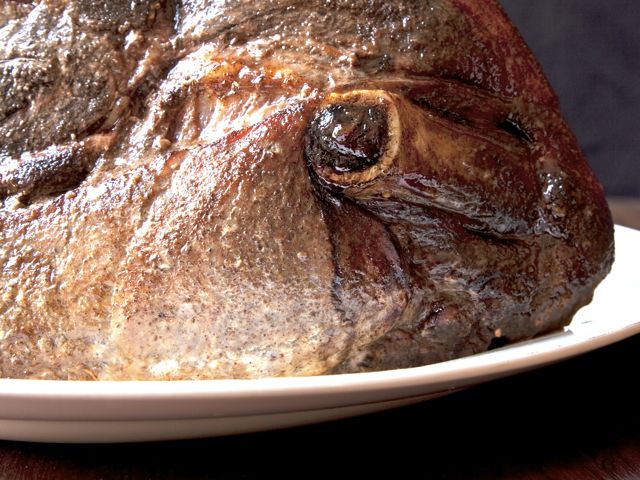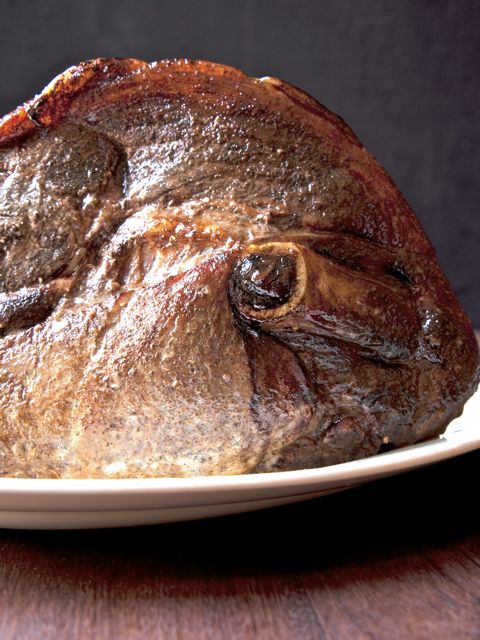
primary-image, l
(article, Bruce Weinstein)

primary-image, l
[%pageBreakSettings nobreak=true] In 11 years, my partner Mark Scarbrough and I have written 18 cookbooks, most in a Manhattan apartment with a kitchen that was only four feet wide, including the appliances. Mark always says that if Sylvia Plath had had our apartment, she’d be alive today. No one could get their head in that oven. [[block(sidebar). h1.Featured recipe]] As a chef, it’s my job to create the recipes, the flavor of the book. Mark, on the other hand, is the writer, its voice. Our latest creation, Ham: An Obsession With The Hindquarter, is about his relationship with ham, with me, and with the South, all blended with my recipes. But how did I, a Jewish kid from New York, come to co-write a book on ham, the most Christian of all meats? When I was growing up, my family shunned ham. Not all ham. We ate prosciutto crudo. We didn’t call it ham. (We didn’t call it crudo, either.) We probably didn’t even know it was ham. But we sure balked at the classic American take on ham: the ubiquitous, spiral-sliced, wet-cured, smoked ham that Mark grew up with as a Southern Baptist. [%image ham float=right width=300 caption="Bruce's Roasted Fresh Ham with a Maple-Spice Glaze."]Back in Texas, Mark says his Jewish friends ate ham. I suppose they had to assimilate or starve. The first time I met Mark’s parents, his mother was preparing shrimp for dinner — until she remembered that I was Jewish and might not eat shellfish. Mark reassured her that it was OK, but she said she didn’t want to cause any problems — so she might just fix a ham. My family wasn’t kosher by any means. We ate shrimp in lobster sauce, spare ribs, and sweet-and-sour pork every Sunday night at King’s Chinese in Bayside, Queens. And it gets worse: my mother’s traditional Hanukkah meal has always been latkes and pork loin. But why was ham verboten — a German word used often by my mother, a woman who wouldn’t even ride in her friends’ new Mercedes? Not even an entire box of kosher salt could move this succulent cut of meat up to the status of bacon — which my grandmother from the shtetl in Belarus prepared with abandon, but always in a separate skillet bought just for the activity. In short, a ham is the rear end, the hindquarter. And the back end of any animal, even a kosher one, is verboten. But even that couldn’t keep me away. My first taste was in the 1970s, at my cousin Olga’s house on Long Island. In the center of the table sat a wet-cured, spiral-sliced, smoked ham, brown and crunchy on the outside and glazed with oranges and brown sugar. My mother and grandmother were horrified — and left hungry. I took a small piece — it might well have been a communion wafer in my grandmother’s eyes — and never turned back. What I didn’t know was that my first experience, like all first experiences, was not the whole thing. Unlike my first ham, American country hams are dry-cured, rubbed with salt and spices, and cured at an ambient temperature before being smoked (or not), then hung to dry for as long as two years. After his trip to Kentucky for our ham book, Mark brought one home: hard, gnarly, and covered in green and purple mold. Eating this had to be crossing a line of some kind. But the Southerner knew what to do. Mark scrubbed off the mold and soaked the thing in a cooler for three days, changing the water every day, until he claimed it was ready for roasting. We placed the ham in a large roasting pan and filled it halfway with water and vinegar. The ham braised in the roasting pan for hours until we drained the liquid, removed the rind, and roasted the ham uncovered for the rest of the afternoon, brushing it with a combination of orange marmalade and bourbon. This ham had a deep, complex flavor that reminded me vaguely of prosciutto. Both kinds of ham are aged at an ambient temperature for years and develop similar flavor compounds that lend rich, exotic aromas to the meat. If this Jew had an epiphany back on Long Island decades earlier, he was now ready for the rapture. Of course, I thought. Prosciutto is ham, too. I couldn’t wait to tell my mother. As we wrote this book, my journey to pig paradise had one more stop: fresh ham. As Mark tells it in the book, we shared our first together when we slaughtered our own pig. Ah, that trip to the abattoir. I leave it to his narrative, but I will say that fresh ham was the best pork roast I’d ever tasted. We even brought one down to Mark’s parents for Easter last year. I watched Mark go through a ridiculously hilarious escapade as he carried the thawing hunk through security. Why did I hang back? Did I think I would be caught? It wasn’t illegal. We weren’t flying El Al. It’s sad that my grandmother didn’t live long enough to see any of our 18 cookbooks get published and win awards. But I think that even my grandmother would approve of Ham: An Obsession With The Hindquarter as much as Mark’s family. She always kept a separate pan for the bacon, but we kept a separate book for the ham. p(bio). Bruce Weinstein and his colleague Mark Scarbrough are contributing editors at Eating Well_ magazine. They keep a blog called Real Food Has Curves, which is also the name of their next book, out in May.

bruce, l

reference-image, l

ham, l